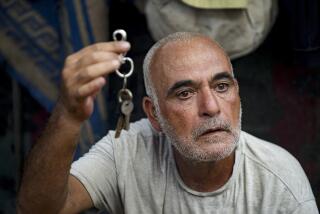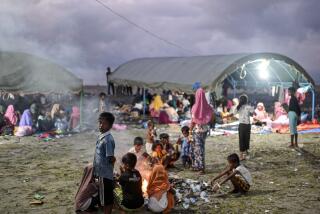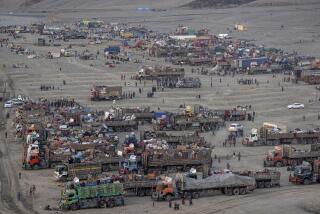Many Pakistanis choose to stay and guard their flooded homes
Reporting from Sadiq Kalhoro, Pakistan — Up in the boughs of acacia trees, farmers squat in makeshift nests, looking for thieves and waiting for the day when the ruinous Indus River finally recedes.
When the rescue boats came to their submerged village, they chose to stay and safeguard the only possessions they’ve ever accumulated: a few water buffalo, some goats, stacks of wheat. Their huts destroyed, they’ve found refuge in trees, on rooftops or on swatches of mud.
“Everything I own is here in this village,” said Khuda Baksh, an emaciated Pakistani farmer who joined with other villagers to hastily build large mounds of dirt so their livestock would be above the floodwater. “I preferred to stay and protect what I have.”
The lives of an estimated 20 million Pakistanis have been disrupted by this summer’s catastrophic floods. Many of them fled on foot or in vans, helicopters and rescue boats. Many, however, decided to stay behind.
Choosing to become castaways carries risk, but losing everything they have frightens them more.
“Here in this area, there are about 20,000 people who chose to stay,” said Pakistani army Lt. Col. Sheharyar Butt, in charge of a squadron of rescue boats moored along the Indus Highway where it disappears into an expanse of brown water in northern Sindh province. “This area’s famous for looters and thieves, so they thought it’d be better to stay put. Wherever there’s a dry patch, they’re surviving.”
In Sadiq Kalhoro, 500 people eke out an existence without electricity, on land so saturated that it swallows up their feet when they walk, drinking river water tainted by the bloated carcasses of cattle and sheep.
They have been living primarily on dates, bread, beans and potatoes, rationing their dwindling food supplies. The village itself has become an archipelago of brackish pools and patches of mud. Some of the homes are still standing, but most are piles of rubble and thatch.
Adaptability has become a prerequisite for survival in Sadiq Kalhoro. An empty plastic antifreeze jug serves as the community life preserver for villagers who swim near the roiling, swift currents of the bloated Indus. Lines of bricks placed a few feet apart in the mud become makeshift footpaths. Orange henna, typically used by Pakistani brides to adorn their hands with filigree motifs, cover the hands and feet of villagers who believe it wards off rashes and other skin ailments that can come from wading in floodwater.
And up in the trees, villagers built 50 nests as temporary dwellings. Mohammed Amin lashed logs and thick branches together with rope to make a triangular floor that fit snugly between three trees. The structure is strong enough to hold beds, clothes and the sewing machine he salvaged from his flooded home.
He put his wife and six children on a military rescue boat that evacuated about 250 people nearly three weeks ago, but Amin, 25, his mother and two sisters chose to stay. The women have since contracted stomach ailments from drinking dirty water, Amin said.
Amin is convinced that he made the right move. Although the village is surrounded by water, looters could sneak up on boats at night. “The other concern is a lack of trust within the village,” he said. “There’s a lot of fear here that your neighbor could steal something.”
Those who have stayed behind say they’ve heard that that life isn’t any better at the relief camps. Every indication suggests they’re right: Fights routinely break out over sacks of flour and rice at the camps, and with cases of malaria and gastrointestinal diseases sharply on the rise, medicines are hard to come by.
In Ghauspur, a farming community of 40,000 about 150 miles northeast of Sadiq Kalhoro that has been transformed into an island by the floodwater, villagers who refuse to evacuate rely on boat trips every other day to replenish supplies of wheat, vegetables, medicine and fodder for their cattle. On one of those trips, 50 men, women and children were jammed shoulder to shoulder on a creaky, perilously overloaded wooden skiff.
“We know this is dangerous,” teacher Riaz Mohammed said. “This boat is leaking, and our women and children are on here. But we prefer a life like this.
“Whatever they say about the relief camps is rubbish. Anyone who has left is living a miserable life on a roadside or in the camps. So we think it’s better to live here.”
alex.rodriguez@latimes.com
More to Read
Sign up for Essential California
The most important California stories and recommendations in your inbox every morning.
You may occasionally receive promotional content from the Los Angeles Times.










